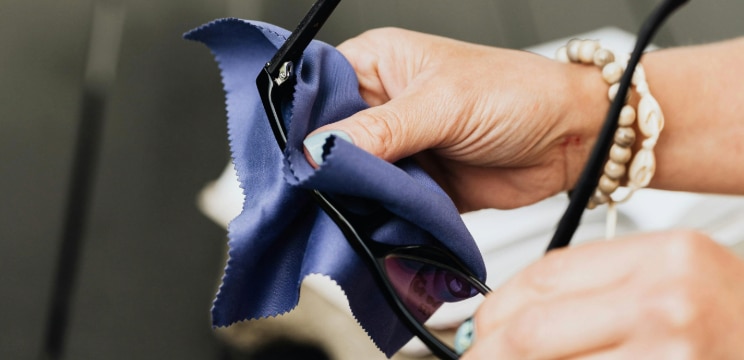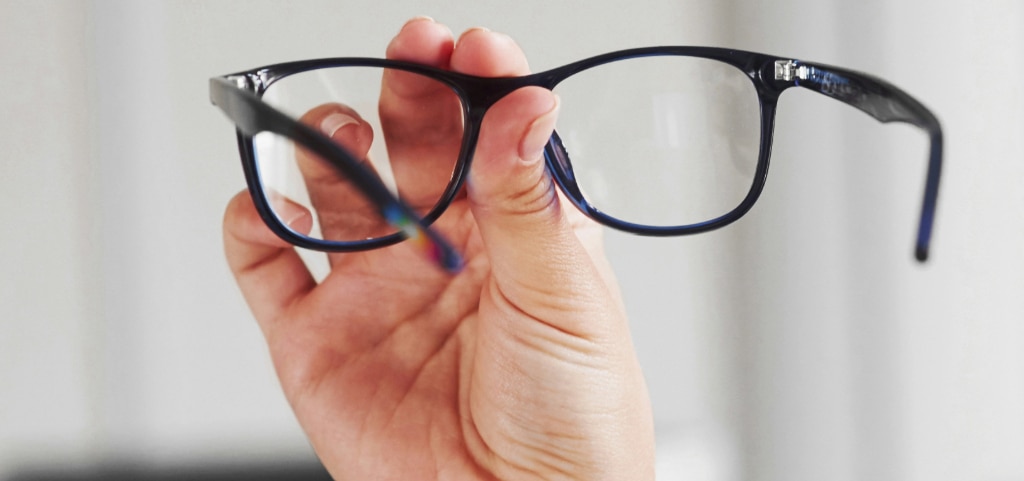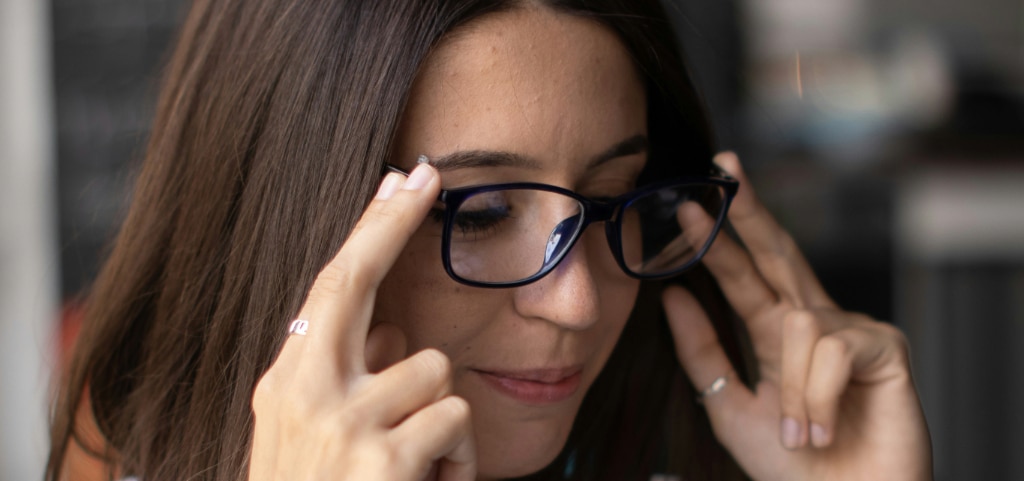Fed up with constantly having to push your glasses back up your nose? You’re not alone. We’ve all been there – that annoying moment when glasses slip or even fall off your face at the gym, or when bending down to grab something. Glasses sliding down is one of the most common annoyances for wearers. Fortunately, you don’t need to suffer, there are plenty of quick fixes and expert tips from Glasses Direct to help keep them comfortably and securely in place.
Whether it’s due to sweating, poor fit, or wear and tear, here’s how to stop glasses slipping down your nose.


Adjust the nose pads of your glasses
Most metal frames have adjustable nose pads which are designed to support your glasses comfortably on your face. If your glasses keep sliding down your nose, try gently tightening the nose pads.
How to tighten eyeglass nose pads:
Grip the glasses in one hand, with the front facing you. With the other hand, use your thumb and forefinger to gently pinch them closer together for a tighter, secure fit on your nose. This will prevent slippage and help your glasses stay put. If the nose pads feel too tight or dig in, move them slightly apart for a looser fit.
👓 Top tip: If you’re unsure, most opticians can adjust glasses nose pads for free in just a few minutes.

❓ Why it matters: Glasses that sit too low can affect your vision, especially if you’re a multifocal or blue light glasses wearer. A quick adjustment can prevent blurry vision and headaches caused by misalignment.
Read our helpful guide to adjusting your glasses for step-by-step instructions.



Use anti-slip wax for glasses
A simple, mess-free way to stop glasses sliding is to use anti-slip wax. Products like Nerdwax, or other beeswax-based options can be applied to the bridge of your glasses to create friction between your frames and your skin, helping your glasses stay securely in place.
If you don’t have any glasses wax to hand, a dab of face primer or even hair wax can work just as well. Reapply as needed, especially if you have oily skin or exercise regularly. This simple trick is another great option if you’re wondering how to stop glasses slipping when you’re on the move.



Clean your nose bridge and glasses regularly
Oil, sweat, and skincare residue can reduce grip and make glasses slip. Make it a habit to keep both the bridge of your nose and your glasses clean, especially if you have oily skin.
Quick fix:
- Use mild soap and warm water or a dedicated glasses cleaner
- Gently wipe your nose bridge with an oil-free cleanser
- Avoid greasy moisturisers and heavy makeup around the nose area
💡 Top tip: Keep a travel-size cleaning kit handy with lens spray and a microfibre cloth, or use single-use lens wipes to keep your glasses clean when you’re out and about.



Add silicone nose pads for better grip
If slipping glasses are a constant annoyance, silicone nose pads can make a huge difference. They’re inexpensive, discreet, and help your prescription glasses stay secure for a comfortable, pressure-free fit—especially for lower-priced plastic frames that lack built-in pads. Simply stick them to the bridge area for a non-slip, cushioned fit.
Non-slip nose pads for glasses also help distribute weight evenly — perfect for those with sensitive skin or low nose bridges.
🧼 Top tip: Always clean the surface before applying for best results.



How to fix loose glasses
Over time, the arms of your eyeglasses can loosen, causing them to slide forward. If glasses are too loose, tightening the arms is one of the easiest quick fixes to stop glasses from moving when you bend or exercise.
How to make glasses fit better at home:
- Use a small screwdriver to check and tighten any loose hinge screws
- For plastic frames, gently heat the curved ends with a hairdryer for 20–30 seconds and then carefully bend them inward for a closer fit behind your ears
🎥 Watch our video to find out how to stop glasses slipping by adjusting the arms. Or visit your local optician for professional help and eyewear repairs.



Use eyewear bands, ear hooks, or ear grips
If your glasses slip while running or working out, accessories like soft silicone ear hooks, eyewear bands, or retainers can make all the difference. These attach to the ends of your glasses frames to keep them securely in place behind your ears or around your head — ideal for sports, outdoor adventures, or hot weather.
For an upgrade without accessories, explore our dynamic Champion eyewear range. Many frames feature unique adjustable temple tips, allowing you to tailor the fit for optimal comfort and a secure, stay-put grip.
🏃♀️ Quick fix: For a quick, temporary solution, wrap small rubber bands or hair ties around the arms of your glasses for added grip.



Try sports glasses with built in grip
If you have an active lifestyle or often struggle with slippage, consider upgrading to durable sports eyewear. Brands like Oakley and our own Harrington Sport range are designed with grip-enhancing features, such as:
- Oakley’s Unobtanium® ear and nose pads stop glasses slipping, even when you sweat
- Flexible spring hinges for movement without pressure
- An ergonomic design built for comfort and durability
🏋️ Explore our full range of sports glasses designed for performance and comfort.



Get a better fit or repair your glasses
If you’ve tried everything and your glasses still slip, they may simply not be the right fit. Loose screws, worn hinges, or poorly sized frames can all cause movement.
Fix it fast:
- Use a glasses repair kit to tighten screws
- Visit your local optician for a professional adjustment
- If your frames are beyond repair, it may be time for new glasses
At Glasses Direct, we offer a wide range of frame sizes. To find your ideal glasses fit, use a ruler to measure your face (width, nose bridge, and temple length) and compare it to each product’s dimensions on our website to ensure your glasses stay in the ideal position without sliding.
Don’t forget to measure your pupillary distance (PD) — the distance between your pupils — which helps ensure your lenses are positioned correctly for clear, comfortable vision.

📏Try our Best Fit Machine — it helps you find glasses that fit just as well as your existing pair do.



How to choose glasses that stay put
Glasses are made up of several key parts. When shopping for new glasses, look for these design features to help prevent slipping:
- Lightweight materials like acetate or metal that fit your face
- Spring hinges for flexibility and durability
- Adjustable nose pads or spacious keyhole bridges
- Curved ‘hockey stick’ temples that hook behind your ears for a secure fit
- Straight arms — ideal when wearing glasses with sports helmets, headphones, or hearing aids
If you have a smaller face, visit our sunglasses for small faces guide to learn how to measure and choose frames that fit perfectly. Don’t forget to explore our face shape guide for inspiration on what styles suit your unique features.


Enjoy a better-fitting pair of glasses
Glasses that stay comfortably in place make a world of difference — whether you’re working, exercising, or just going about your day. With these simple hacks and fit-friendly features, you can stop glasses slipping down your nose and focus on what really matters.
✨Find your perfect pair today at Glasses Direct — with free Home Trial, expert advice, and styles designed for comfort and confidence.




